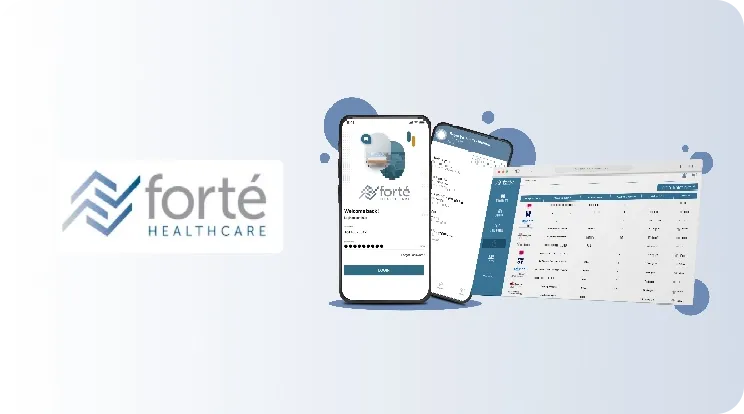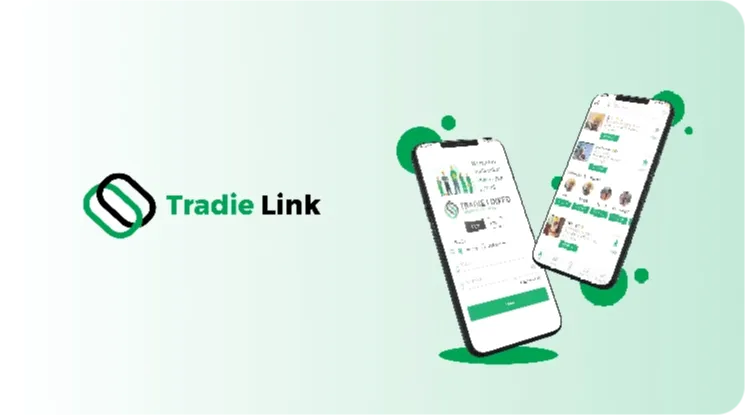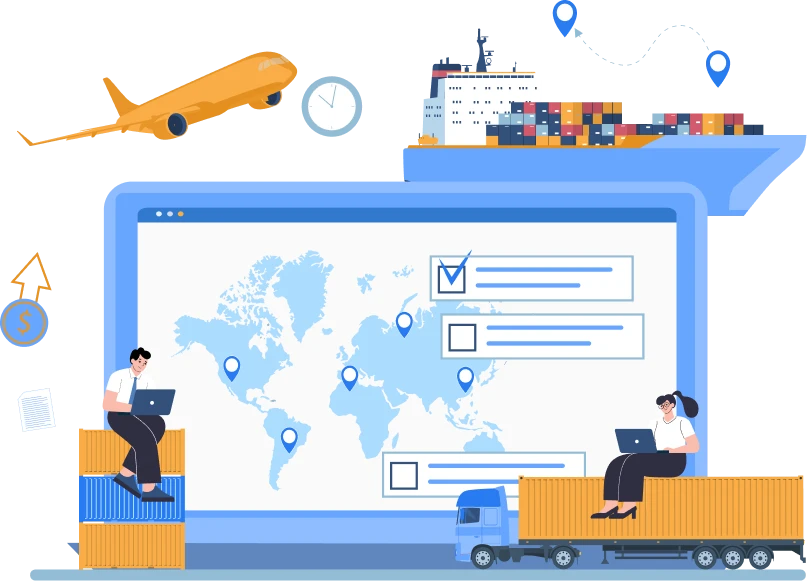
IoT in Supply Chain and Logistics: Benefits, Use Cases, and Challenges in 2024
April 04, 2024
The supply chain network and logistics in the world are facing unusual transformations or changes. It fulfils the necessity of adopting the technology of Industry 4.0. Along with its difficulties and challenges. This technology is used for analysing and providing solutions. Logistics and supply chain networks are moving to the technology of Industry 4.0. And its solutions. Along with this technology, the Internet of Things (IoT) has a critical component. IoT is very important among these solutions. It is beneficial in many ways in the supply chain.
Industry 4.0 is integrating digital technologies that are bright. Technologies into industrial processes and manufacturing. It surrounds a set of technologies. That also includes IoT networks for industrials. It also includes AI, automation, big data, and robotics.
At present, the IoT is creating a transformation in SCM (supply chain management). Progressive organizations grasp the devices of IoT. It transforms complex supply chains. That too is into fully connected networks. For the verticals of SCM, monitoring and tracking are some of the leading objectives for the deployment of IoT. The technology assists fleet managers and warehouses. It is for keeping track of their inventory and cargo.
End-user solutions for IoT in the market around the world. The market size is expected to grow to more than 200 billion USD. The data is by the end of 2019. In terms of revenue from the market, technology has reached 100 billion USD. That was also the first time in 2017. This forecast recommends that this figure will rise to more than 1.5 trillion. That too is within 2025. This article will discuss the importance of IoT for logistics advantages, use and SCM. We will also study their used cases, advantages and many more.
Important challenges in the supply chain if IoT is not utilised:
- In a traditional supply chain, tracking vehicles is like running in a maze with eyes closed. Increasing of lead times, delays and huge cost is caused due to a factor. There is an absence of visibility in the location and status of the shipments.
- Businesses need assistance in the underutilisation of assets. Assets like machinery, vehicles, and facilities of storage. This efficiency can lead to maximum expenses in operations. It can also alleviate profit margin.
- Conventional methods of demand forecasting have a high chance of errors. It often results in stockouts or overstocking. It can lead to opportunities for missed sales, wastage and unhappy consumers.
There is no doubt that it has heightened these continuous issues. Yet, it might be the real reason, which is unlikely. Reasons behind the difficulties associated with it. It is crucial for identifying and addressing fundamental issues. It can ensure that supply chains meet the economic demands of the world.
This article will help you gain insights. Insights into how the implementation of IoT in logistics and the supply chain is advantageous for your business. In this article, we will also study all the advantages of IoT in the supply chain. And all the cases and challenges that are involved. Especially those with IoT implementation in supply chains and logistics. IoT solutions can significantly improve SCM optimization. And, in the process of logistics, It brings cost-friendliness and transparency. It cannot be achieved with advanced technology.
Here is how it works in SCM if you are new to IoT. Especially in IoT shipment tracking. Devices that have internet connectivity enable data collection in real-time. It is about goods being transported and stored. And the status of shipment and level of inventory. And, in terms of the conditions of the environment in vehicles and warehouses, Raw data is then analyzed, stored, and processed in a cloud. It enables constant monitoring of shipments from top to bottom. To that of the supply chain. It causes an instant reaction to any kind of change. For instance, if sensors detect obstructions from the fixed temperature of facilities in cold storage, The control applications send commands for the adjustment of temperature to actuators. It notifies operators of the supply chain.
In this article, we will also provide an overview of IoT for logistics and SCM. This article will not only tell you how IoT is beneficial in logistics and SCM, but it will also prove itself. As a value. That is also a true example. If you are looking forward to managing your operations in the logistics and supply chain, Too, with the modern approach. Please stay with us through this entire article.
How IoT is Beneficial for Supply Chain Management and Logistics
Supply chain management is a process consisting of multiple stages. Many roles are involved in it. Each role grasps the advantages of IoT. Material from their technological raw materials suppliers use solutions of IoT. It is for keeping track of their processes. The examples for such IoT tracking are as follows:
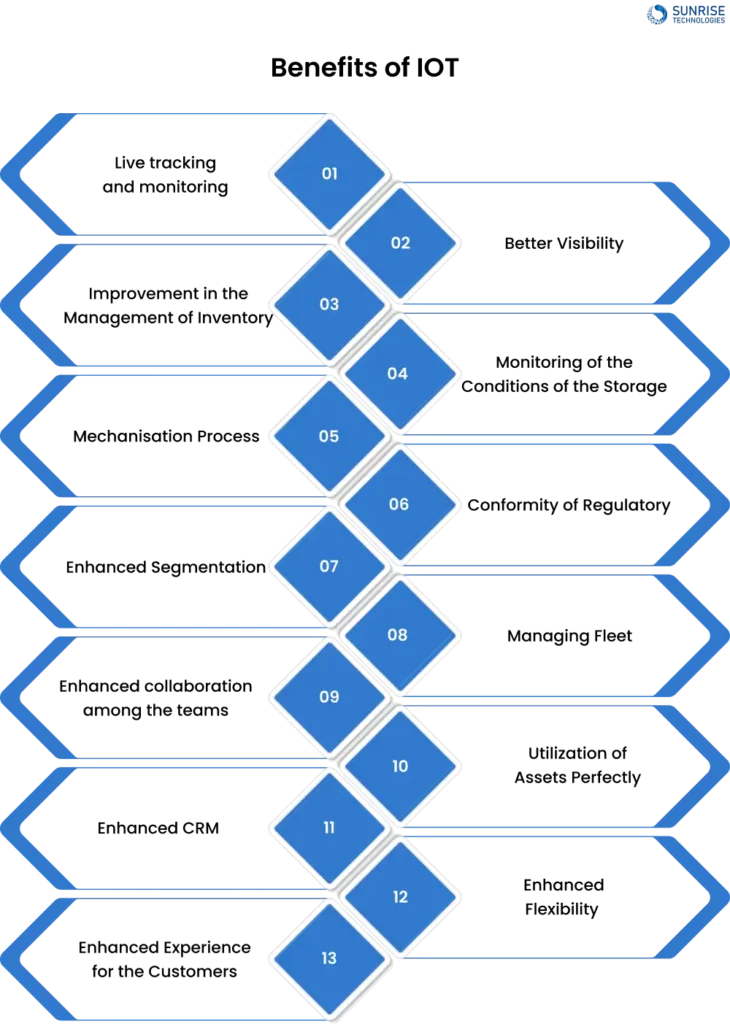
- Data in real-time for crop conditions.
- Livestock health in agriculture and farming.
- Monitoring fire accidents.
- Operations of logging in forestry.
- Oil composition analysis. That is also true within pipelines for the extraction of oils.
- Sensors and RFID tags on merchandise help the stores monitor levels of stock. It also helps in tracking the movement of the products. It also helps in identifying shoplifting instances.
- Healthcare facilities and hospitals use asset tracing. It is to monitor medications, patients and medical equipment.
These data assist in boosting real output. It further enhances the quality of raw materials. It also decreases the consumption of energy. It helps in ensuring profitability too. Manufacturers introduce solutions to IoT. It is for monitoring the operations of manufacturing. Condition of equipment in real-time. Ongoing supervision assists in identifying bottlenecks. It makes crucial adjustments. It thus decreases downtime. It increases the utilization of assets. It thus improves efficiency in production. IoT also promotes sustainability. It tracks the utilization of water and power. Along with monitoring levels of emissions. It aids in compliance with environmental regulations. It also helps in implementing green strategies.
Precision and transparency in logistics are brought about by the IoT. Logistics operators collect real-time location data. Along with the position of every asset. They can optimize and track the entire route of delivery with this data. Especially in cases of delays or changes. Solutions for IoT also help in the management of cold chains. It keeps perishable items safe. It is by detection of obstructions from suggested transportation conditions. IoT helps in the facilitation of tracking inventory. It further helps in improving accuracy and visibility. The improvement of operations in warehousing. The solutions of IoT also contribute to the preservation of perishable goods. It is through monitoring the conditions of storage. Retailers get eased during the process of pickup and loading-unloading. IoT solutions enable process optimization. It boosts selection accuracy. It tackles efficiency. A solution to IoT can help in tracing goods across racks. It maximizes the visibility of inventory. It further helps in monitoring store traffic. It is to optimize the display of goods. And utilization of space.
Thanks to the IoT. Complicated supply chains are becoming networks with connections. Data collection from IoT devices helps streamline the operations of the supply chain. It involves correctional actions that are prompt. It is to remove or decrease all losses. Along with all that, let us scrutinize the benefits of the IoT. Its benefits are in the supply chain and logistics. That also has more details.
Live tracking and monitoring
One of the most beneficial aspects of the IoT system is its ability to analyze, collect, and transmit data. That was also done in actual time using sensors of a special kind. Since you have gotten data promptly and straightforwardly, this feature is beneficial. That too is for creating easy transportation and supply chains. It makes it easy to organize and oversee. Solutions for IoT in SCM enable professionals to evaluate products promptly. It is to evaluate stocks and their conditions. And for making quick reactions to any changes in the order status, and so on.
Better Visibility
In every stage of the supply chain, IoT plays a major role. Whether it is manufacturing or retail. It is from manufacturing and retail. Suppliers of raw materials use the Internet of Things devices. It is to gather data on timely influencing factors. And the quality and availability of the deliverability. For example:
- Monitoring the health of crops for agriculture.
- Operations of logging from forestry.
- Farming livestock health.
Similarly, retailers use IoT to improve goods pickup accuracy. It also elevates the efficiency of material handling. They are also beneficial for tracking products across racks. It is for better management of inventory. It is also for checking traffic in the store. It is for enhanced space utilization and display.
Improvement in the Management of Inventory
You must track inventory. It is also controlled to manage the supply chain effectively. In warehouse management, IoT in SCM analyzes and collects data on stock levels with the help of devices. Positions of inventory for enhanced management. With an inventory system that is IoT enabled, you can detect levels of supply in real-time. You can obtain insights into your inventory status. You can also be able to make wise business decisions. It also prevents shortages of products.
Predictions can be made for future inventory requirements. It can be predicted using the data used in the system. You might detect the physical characteristics of products. For instance, damages, leakages, or packing in a defective way. Without any effort, and also manually, the IoT makes it easy to update information about assets. You can also get access to important information promptly. That is also true for each delivery. It includes instructions for storage. And package content.
Monitoring of the Conditions of the Storage
Solutions for environmental sensors that are developed by IoT in logistics and transportation. It allows management to detect the conditions of cargo. In other words, a cargo tracking system helps to track the movement of shipments. And it takes instant action if anything alters. For example, an IoT system for the supply chain gathers information. It collects data on humidity, pressure, and vehicle temperature. It also includes other variables that could threaten the integration of goods. It also helps in adjustments of the environment accordingly and automatically.
Mechanisation Process
Enterprises in this modern world depend heavily on automation or mechanization. It is to reduce the requirement for physical labour. The risk of mistakes caused by human and labour expenses is also one reason. There are various other reasons, which also include the fast delivery of resources. IoT helps in enabling the supply chain for the production of required automation or mechanization. It is a process of industrials. And the area of management. All these are possible because of the IoT. Drones can be used as a tool for IoT. It is used for managing warehouses. You can also create a whole infrastructure. Especially that can be accessed remotely. It is for tracking the status of logistics.
Conformity of Regulatory
An enterprise must stick to all kinds of obligations. Whether it is regulatory or local legal obligations, In the phase of managing the necessary documentation, As well as standing by the law. IoT helps enterprises maintain regularity and compliance. Along with the prevention of litigation. A system based on IoT helps in providing a trial audit digitally. That is with exact timestamps. And providing reports accurately and quickly. It is one of the most crucial uses of IoT in logistics.
Enhanced Segmentation
Effective strategies might be established by retailers. It is a combination of IoT and SCM. It is for an understanding of products in a better way. Along with that, I also understand demand and consumers. Data collected in a cycle of products helps in researching the market. It also allows the segmentation of products. Along with keeping in mind the target audience and market.
Managing Fleet
These sorts of IoT solutions for logistics and transportation reveal IoT effects in logistics. They are incorporated into more complicated systems most often. Enterprises are required to gather a lot of actual data. That is regarding the condition and availability of each vehicle. It is because they can run as many vehicles as possible. Fleet management tools help businesses smooth their complete workflow.
Enhanced collaboration among the teams
Most of the time, complicated chains of value cause the degeneration of multiple data silos in a frequent manner. Obstructions in the supply chain occur as different sources of information are used by the teams. Which means their communication is not effective. This is specifically true for enterprises using outdated systems. Along with the capabilities of small analytics of data. By utilizing clouds, data silos are broken down by solutions of IoT. In addition to data analysis services. Which provides a true version to all team members along the chain of values. It improves teamwork. As a result, it is now easy to solve problems swiftly.
Utilization of Assets Perfectly
IoT provides connectivity tailored to needs. It is to allow managers of logistics and supply chains to optimize the fleet. They can plan more brilliant routes. They also plan to monitor the efficiency of assets. It also identifies assets that are delayed. And adjusting operations to increase the number of deliveries. Further processes based on artificial intelligence (AI) and machine learning (ML) help decode data. And it is by providing devices that are IoT-based. It carries out analytics done with predictions. It helps in allowing better maintenance of the fleet. It assists in the monitoring of vehicles and the management of cargo. It also helps in operations that are conscious of the environment. Therefore, the IoT offers improved visibility. It also offers savings, security, and manageability. It also decreases downtime. It also helps in using assets optimally.
Enhanced CRM
Logistics software and the supply chains of IoT are of great help to management and customers. It can be considered an important use of IoT in logistics. Most of the companies utilize the IoT advantages in logistics. They also offer a facing app specially designed for customers. The apps for clients can also track order delivery with GPS. And they can also look for their order status. It assists in building trust. It also organizes order accounts that are completed. Especially when customers can track the progress of delivery to the delivery address, i.e., the customers’ home.
Enhanced Flexibility
IoT in logistics and transport helps provide managers with a complete understanding of the movement of goods. It helps managers of supply chains and merchants determine. They determine how many orders to make for each unit of each product. IoT also reduces the human error effect. It is enhanced by the shipping and tracking of assets. It helps with the exact navigation on the road.
Enhanced Experience for the Customers
The flawless functioning of the supply chain helps managers in the expectations of ultimate customers. Expectations in quality and time of delivery It enhances the experience of customers. In turn, it results in the growth of business. Furthermore, they can also take part in shipment monitoring identifying and the actual delivery of products. It estimates the time of delivery accurately. By identification of issues of delivery at an early stage, they can make the right decision. They can also plan for delivery alternatively. It is to meet agreements at the service level.
Role of IoT in Logistics and Supply Chain
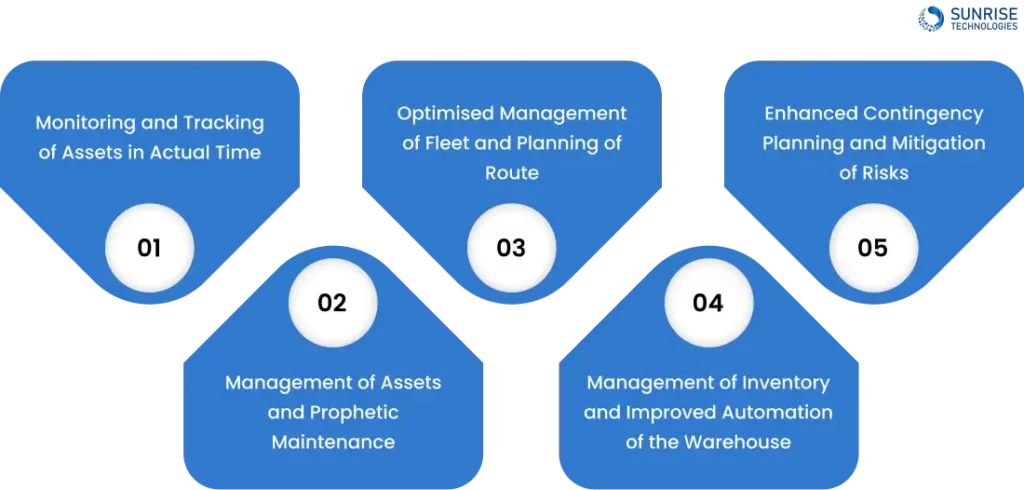
Monitoring and Tracking of Assets in Actual Time
It is one of the most important applications of IoT in logistics and supply chains. By providing assets like vehicles, containers, and shipments with devices and sensors enabled by IoT. Logistics firms can achieve visibility in real-time That also includes the status, location, and condition of their assets. That is, throughout the journey of the supply chain. This visibility helps in allowing enhanced management of inventory. It reduces theft or loss. It also improves the utilization of assets. It further helps in improving customer service.
Management of Assets and Prophetic Maintenance
Sensors that are enabled by IoT can also be used for monitoring the performance and health of assets. Especially those that are critical. For instance, equipment, vehicles, and machinery in actual time. Through analysis of factors like vibration, temperature, and patterns of usage, logistics companies can make predictions. They can predict maintenance issues that may occur before they occur. It enables dynamic maintenance. It also decreases downtime. This approach to prophetic maintenance not only spreads the lifetime of assets. But it also decreases the cost of maintenance. It further enhances efficiency in operations.
Optimised Management of Fleet and Planning of Route
It is optimized by logistics firms when they opt for IoT-enabled technology. It is done by grasping data on the actual time and conditions of traffic. And, in the performance of vehicles and forecasts of weather. By integrating GPS tracking devices that are enabled by IoT. And, by integrating systems of telematics into their vehicles. With the help of both, business owners can monitor the behaviour of the drivers. It also helps optimize the consumption of fuel. It also ensures compliance with the regulatory requirements. It allows for more efficient planning of routes, reduced time of delivery and cost of fuel. It improves the overall performance of the fleet.
Management of Inventory and Improved Automation of the Warehouse
Solutions for warehouse automation are driven by IoT. It enables logistics firms to optimise and streamline the operations of warehouses. From the management of inventory to the fulfillment of orders Companies can automate the tracking of inventory and improve the accuracy of orders and rates of fulfilment. It is done by the deployment of sensors enabled by IoT, barcode scanners, and RFID tags. It results in reducing the holding costs of inventory. It minimizes stocks and enhances the satisfaction of customers.
Enhanced Contingency Planning and Mitigation of Risks
Managers of the supply chain can receive the following causes of delays in shipments:
- It is enabled by the analysis of data on shipments that were consigned previously. And they are gathered by devices that are enabled by IoT. It would also include concerns about data, traffic, weather, potential accidents, and many more.
- Furthermore, they can also diminish risks by developing a plan. A flexible plan. And it has alternative routes. They receive alerts in real-time. When they do, it suggests delays caused by traffic. They also have the option of delivering shipments through a planned path that was previously planned.
Industry Examples Applying to the IoT Supply Chain and Logistics
Integrating the technology of IoT into the operations of logistics and supply chains has created a revolution. It revolutionized processes that are managed by the industry. It also improves efficiency and optimizes the utilization of resources. IoT sensors and devices help with tracking in real-time. It also analyses and monitors shipments and inventory. And other assets as well, like vehicles. It leads to enhanced transparency and visibility. It improves decision-making within logistics and the supply chain. Here are some examples of industries applying IoT solutions. Along with some real-life examples.
DHL
The discussion on the advantages of IoT has been taking place for about two decades. The company staff is asking among themselves about the process for combining operational and informational technology. It is for improving all kinds of processes in manufacturing, industry, and processing.
It took more than a decade before the invention of the first automated device. That also makes true sense. During the 1980s, students from the university got attached to a vending machine on campus via a remote device. That is, by using microchips to keep track of whether the machine was loaded or whether the cans were still cold.
IoT helps in the improvement of logistics for DHL by connecting IoT sensors and devices to the assets of their clients. Assets, as in the bins and roller cages of the warehouse. Then they can contact them. That is where infrastructure and networks emerge. It uses all of them, like RFID and solutions based on cellular. And other technologies of connectivity. They need to submit databases and platforms after having communicated with their assets. So that they can anticipate their information.
Volvo
A system of maintenance that was predictive and wireless as well. It was created by the IoT team of Volvo Group Digital and IT. Supporting the factory in Lyon. To monitor the health of the AGV (Autonomous Guided Vehicle). They also prevented the shutdown. The team checked for the technology of Wi-Fi at the initial stage. However, the 2.4 GHz Wi-Fi band has already been used for evaluative processes in lines of production. Along with facing these challenges, the IoT team looked at LoRa WAN, which is a protocol of LPWAN created for connecting battery-operated items. It is connected to the internet to give power to large amounts of AGVs. LoRa WAN is suited to the process of manufacturing ideally. It provides a long range of capabilities. Plus, the flexible and secure architecture of the network.
Uber
This company has created a revolution in the transportation industry. It also denotes templates for developing car businesses with IoT. They held on fast, taking smartphones from across the world. They have helped make the transportation system agile and smooth. It is by creating a marketplace for both passengers and drivers. It is more cost-friendly for millions of customers. It is causing a disturbance in traditional players. Such as traditional taxis. Which has now become ancient for most people. However, Uber has evolved itself into a huge IoT enterprise.
Amazon
Applications of IoT in logistics can be displayed. That too with a smart warehouse. Routine tasks like rearranging and labelling racks are the performance of a smart warehouse. It is done by using computers and machines. Which was previously done by most humans.
All activities of Amazon are related to making money and lifting heavy weights. They are all performed by robots. Working along with robots, the human staff puts their concentration on tasks that require solving problems. Plus, it also requires capability or talent. For navigating robots easily, warehouse floors consist of embedded QR codes. With the help of IoT, automation has helped Amazon store more than 50% of its inventory. Along with that, retrieving was three times faster. Along with that, the cost of fulfilment is also reduced by 40%.
FedEx
Advanced technology in IoT has helped the logistics industry in creating capabilities. It is advantageous to both receivers and shippers. FedEx has been an initiation in logistics that are sensor-based. Using IoT in delivering enhanced visibility across real-time shipments. SenseAware is an innovation that is used by FedEx in delivering high visibility across shipments in actual time. For consumers, who are looking for services of a special type. For instance, shipments that are sensitive to high-tech, high-value or temperature. SenseAware helps in delivering full tracking and delivering with an extraordinary degree of detail. It includes location, humidity and exposure to light.
Companies can acquire peace of mind now. They can now have complete visibility of their shipments. Visibility across connected networks. Where the sensors are used in sending and collecting data. Alerts are immediately sent out if any occurrence happens. SenseAware is a type of technology that is the starting point of the future that it grasps. It holds a future in appearing tech like Blockchain. Which it become more mainstream.
IoT is undoubtedly a saviour when it comes to its utilisation in logistics and SCM. But still, implementation of IoT has few challenges. They are as follows:
- Poor data security of the devices that are connected to the system of IoT.
- Low Level of Privacy because IoT devices can gather and transfer sensitive information of their users.
- Most of the IoT devices have Low Consumption of Energy.
- Shortages of talent or specialists for handling IoT devices.
If you are looking to implement IoT and want to know more about its possibilities and how to tackle these challenges, you can reach out to us. You can contact us, at Sunrise Technologies for a complete consultation.
We take pride in providing lots of IoT solutions from across the globe for a decade. We shared the challenges because we did not disappoint our clients disappointed. We shared the challenges because we know how to tackle them. For instance, a large volume of data is generated by IoT. They need storing, processing and transferring of the data. IoT systems must use the technology of LPWA to solve this issue. Scalable cloud services, LPWA and solutions of NoSQL can be provided by us.
Sunrise Technologies, a leading blockchain and app development company, can help you if you are looking to know more about IoT and its applications. As the presenters of this blog, we mix security, speed, and scalability. And that is in every aspect of the development services for IoT applications. We know how important it is to maintain a high-performance level.
At Sunrise Technologies, we have established ourselves as a top-notch service provider for IoT application development. We offer solutions for the IoT to enhance productivity. It elevates profits by streamlining both procedures. Either externally or internally.
Sam is a chartered professional engineer with over 15 years of extensive experience in the software technology space. Over the years, Sam has held the position of Chief Technology Consultant for tech companies both in Australia and abroad before establishing his own software consulting firm in Sydney, Australia. In his current role, he manages a large team of developers and engineers across Australia and internationally, dedicated to delivering the best in software technology.














